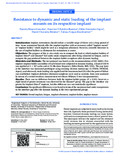Mostrar el registro sencillo del ítem
Resistance to dynamic and static loading of the implant mounts on its respective implant
| dc.creator | Blanco González, Daniela | |
| dc.creator | Villalobos Ramírez, Francisco | |
| dc.creator | Fernández López, Ottón | |
| dc.creator | Chavarría Bolaños, Daniel | |
| dc.creator | Vargas Koudriavtsev, Tatiana | |
| dc.date.accessioned | 2022-03-01T14:11:02Z | |
| dc.date.available | 2022-03-01T14:11:02Z | |
| dc.date.issued | 2021-12-14 | |
| dc.identifier.citation | https://www.jdionline.org/article.asp?issn=0974-6781;year=2021;volume=11;issue=2;spage=78;epage=83;aulast=Blanco-Gonzalez;type=0# | es_ES |
| dc.identifier.issn | 0974-6781 | |
| dc.identifier.uri | https://hdl.handle.net/10669/85908 | |
| dc.description.abstract | Introduction: Implant restorations should endure a variable range of forces over a long period of time. Some commercial brands offer the implant together with an accessory called “implant mount” or “implant holder,” which might be used as a temporary abutment. However, scientific literature in the use of implant holders as abutments for restorations is scarce. Objectives: The purpose of this in vitro study was to compare the load at which implant holders of Implant Direct® and Zimmer® fail under static compression after being subjected to fatigue, and to compare the gap produced between the implant–holder complexes after dynamic loading. Materials and Methods: The test protocol was based on the recommendation of ISO 14801. Five implant–implant holder assemblies of each brand were subjected to dynamic loading. A load of 250 N was applied at 5 × 106 cycles and at 15 Hz stress frequency (Eden Prairie, MN, USA). The gap (µm) at the interface was measured postfatigue using scanning electron microscopy (S‑3700N, HITACHI, Japan), and afterward, static loading was applied and the maximum load (N) after the point of failure was established. Implant–definitive abutment complexes were used as controls. Data were analyzed by means of a central tendency measurement test Mann–Whitney U‑test (nonparametric). Results: There was no difference between both the implant holder groups (P ≤ 0.05); however, a slight trend of greater resistance was observed for the Zimmer® group. The gap in the interface was greater for Implant Direct® implants, but the difference was not statistically significant. Conclusion: No significant differences were found in terms of the maximum load under compression or the interface gap after the dynamic loading in the two experimental groups. | es_ES |
| dc.description.sponsorship | Universidad de Costa Rica/[]/UCR/Costa Rica | es_ES |
| dc.language.iso | eng | es_ES |
| dc.source | Journal of Dental Implants, vol.11(2), pp.78-83. | es_ES |
| dc.subject | Dental implant | es_ES |
| dc.subject | Fatigue | es_ES |
| dc.subject | Implant abutment | es_ES |
| dc.subject | Implant holder | es_ES |
| dc.subject | Implant mount | es_ES |
| dc.subject | TECNOLOGÍA MÉDICA - ODONTOLOGÍA | es_ES |
| dc.title | Resistance to dynamic and static loading of the implant mounts on its respective implant | es_ES |
| dc.type | artículo original | es_ES |
| dc.identifier.doi | 10.4103/jdi.jdi_4_21 | |
| dc.description.procedence | UCR::Vicerrectoría de Docencia::Salud::Facultad de Odontología | es_ES |
| dc.description.procedence | UCR::Vicerrectoría de Investigación::Unidades de Investigación::Ingeniería::Laboratorio Nacional de Materiales y Modelos Estructurales (LanammeUCR) | es_ES |
Ficheros en el ítem
Este ítem aparece en la(s) siguiente(s) colección(ones)
-
Odontología [152]


